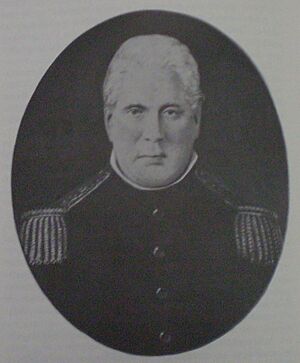Battle of Pequereque facts for kids
Quick facts for kids Battle of Pequereque |
|||||||
|---|---|---|---|---|---|---|---|
| Part of Bolivian War of Independence Argentine War of Independence |
|||||||
|
|||||||
| Belligerents | |||||||
| Commanders and leaders | |||||||
| Strength | |||||||
| 135 cavalrymen | 150-200 cavalrymen | ||||||
| Casualties and losses | |||||||
| 3 dead 10 wounded |
10 dead 20 wounded |
||||||
The Battle of Pequereque was a fight that happened on June 19, 1813. It was part of the second Upper Peru campaign during the Argentine War of Independence. This battle involved scouting groups from the United Provinces' Army of the North and the royalist Army of Peru.
The cavalry (soldiers on horseback) from the Army of the North, led by Colonel Cornelio Zelaya, won against the royalists. The royalist forces were commanded by Colonel Pedro Olañeta.
Why the Battle Happened
After General Pio de Tristan surrendered at the battle of Salta on February 24, 1813, the United Provinces' Army of the North gained an advantage. They were strong in northern Argentina and southern Upper Peru (which is now Bolivia).
At the same time, the royalists were having leadership problems. General José Manuel de Goyeneche had resigned. Spanish soldiers became worried after Tristan's defeat. They quickly moved their troops from Jujuy and Potosi to Oruro, in central Upper Peru.
In early May, the Army of the North reached Potosi. A small group of about 500 soldiers was sent ahead towards Oruro. These soldiers were a cavalry regiment called Dragoons, led by Colonel Cornelio Zelaya.
The Fight at Pequereque
The republican army's leading group slowly moved from Potosi. They passed through villages like Yocalla, Las Leñas, Tolapaca, and Vilcapugio. They then set up their main camp in the small village of Ancacato. This village had been partly damaged by the royalists.
On June 17, the soldiers in Ancacato needed more food. A small group of Dragoons went to Challapata, about 12 kilometers (7.5 miles) away, to find supplies. They did not know that a royalist regiment, called Cazadores and led by Colonel Pedro Olañeta, had already taken Challapata.
Two days later, a local person warned the Dragoons that enemy soldiers were marching towards them. Colonel Zelaya immediately prepared his forces for a fight. He wanted to meet the royalists head-on.
Zelaya chose one of his officers, Juan Francisco Zamudio, to lead a group of mounted soldiers. Their job was to face the royalists, who had taken the small town of Pequereque. Pequereque was at the other end of a valley.
Meanwhile, a group of infantry (soldiers on foot) was placed behind them. This was to stop any enemy soldiers from sneaking in. The rest of the regiment was also ordered to march on foot. This was to make the enemy think the republican forces were smaller than they actually were.
The battle lasted for about five and a half hours. This information came from the official report sent to General Manuel Belgrano, who was the army's commander. The royalists eventually gave up, and Zelaya's men took control of Pequereque.
According to Zelaya's report, three republican soldiers died, and 10 were injured. He reported that Olañeta's forces had about 10 dead and 20 wounded. Royalist reports also mentioned they had casualties, but did not give details. After holding Pequereque for a few hours, Zelaya decided to move his troops back to Ancacato.
What Happened Next
Olañeta's troops took back Pequereque three days after the battle. The Dragoons moved back to the plain of Vilcapugio. They wanted to avoid another fight with the enemy, who had gathered most of their forces around Ancacato. Two days later, Zelaya moved his main camp even further south, to Las Leñas.
Later, Colonel Zelaya was replaced by Colonel Juan Ramón Balcarce. General Belgrano sent Zelaya to Cochabamba. His mission was to gather a larger cavalry force from local volunteers. Zelaya would later rejoin the main army after the defeat at the Battle of Vilcapugio.
See also
 In Spanish: Combate de Pequereque para niños
In Spanish: Combate de Pequereque para niños


